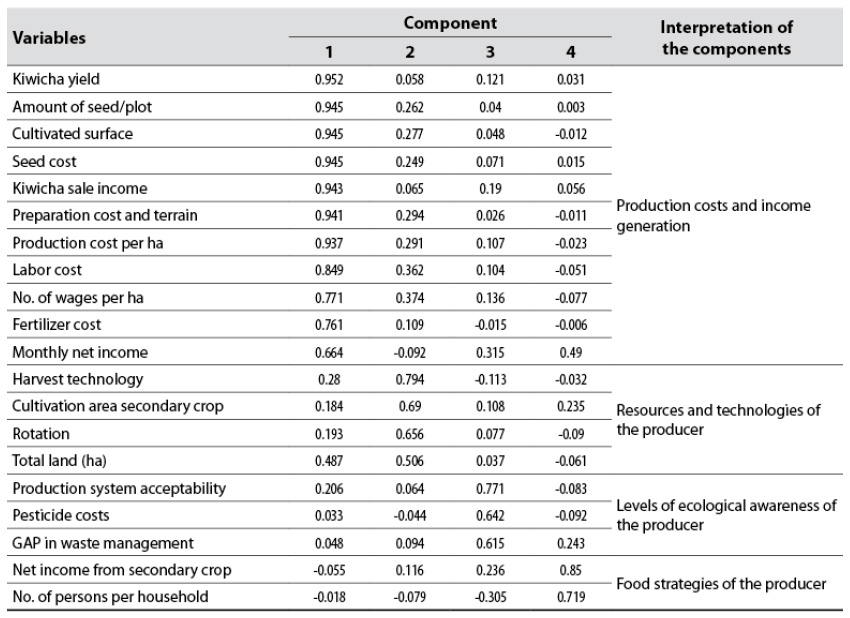Introduction
In South America, kiwicha Amaranthus caudatus L. (Amaranthaceae) is cultivated in marginal areas of the inter-Andean valleys in small-scale plots generally associated with maize (Zea mays L.) (Veneros & Chico, 2017). It is the only amaranth species that grows at altitudes greater than 2,500 meters above the sea level. (Espitia et al., 2010). In Peru, the promotion of its cultivation and its demand increased as a non-traditional export crop in the 1980s. Currently, the department of Cuzco, followed by the department of Ancash, is the highest production area of this grain (Ministerio de Agricultura y Riego [Minagri], 2016). Its cultivation within the family farming system is strategic to improve nutritional quality and family income; however, promotion, credit, and technical assistance policies are required to favor this crop (Sánchez et al., 2016).
During the 1994-2012 period in Peru, the agrarian structure has changed in terms of the number of production units, the number of farmers, and land tenure (Instituto Nacional de Estadística e Informática [INEI], 2013; Maletta, 2017; Ponce et al. al., 2015). Moreover, the agrarian structure of the department of Ancash is characterized by the diversity of productive systems and their physical, socio-economic, or technical components (Barreto, 2017). Therefore, multi-dimensional studies are required to know and characterize them (Coronel de Renolfi & Ortuño, 2005; Escobar & Berdegué, 1990).
This first approximation is useful to establish relationships between variables and economic, environmental and social indicators (Vargas & Sánchez, 2015), in such a way to facilitate a dynamic interpretation of agroecosystems and the formulation of viable recommendations with a multi- dimensional approach (Apollin & Eberhart, 1999; Carrillo et al., 2011; Coronel de Renolfi & Ortuño, 2005).
Accordingly, the aim of the research was to characterize the productive units of kiwicha cultivation and establish the typologies of producers in five communities located in the provinces of Yungay, Huaylas, and Carhuaz, in the department of Ancash, Peru, to explore some topics that could become research topics in the Andean small grain producer sector.
Materials and methods
The study was carried out in the sphere of influence of three provinces and five districts of the department of Ancash, considered as the main kiwicha producing areas (table 1).
Table 1 Location, population, and geographical description of the study areas of the department of Ancash, Peru

Source: Elaborated by the authors, adapted from Instituto Nacional de Estadística e Informática (INEI, 2017)
To define the agricultural unit (AU) sample under study, of a population of 448 producers using the probabilistic sampling technique, the total population of kiwicha producers was divided into different subgroups or strata. The methodological procedure of an unrestricted random proportional and stratified type allowed defining and dividing a sample of 115 producers (Martínez- Reyna, 2013; Pinedo et al., 2018) into the five most representative districts of kiwicha cultivation in the department of Ancash, who provided the necessary information to define the characteristics of different types of producers (Pinedo et al., 2018).
The typology of the production systems was made from the analysis of access to cropping land, cultivated area, labor availability, crop management, and yield, as well as the different combinations of cropping systems practiced by production unit. Furthermore, also including the processes of differentiated accumulation in capital (production costs, net family income), and the level of intensification of agricultural units (crop rotation practices), considering the methodological proposals proposed by Escobar and Berdegué (1990), Apollin and Eberhart (1999), and Maletta (2017).
This facilitated the development of questionnaires with structured questions (Pinedo et al., 2018), associated with 61 primary qualitative and quantitative variables, defined and coded for further processing and analysis (Coronel de Renolfi & Ortuño, 2005). Of the 61 original variables, those that could effectively contribute to the desired typification were selected (table 2).
Table 2 Variables under study selected for the characterization of the kiwicha (Amaranthus caudatus) productive units in chosen areas of the department of Ancash, Peru
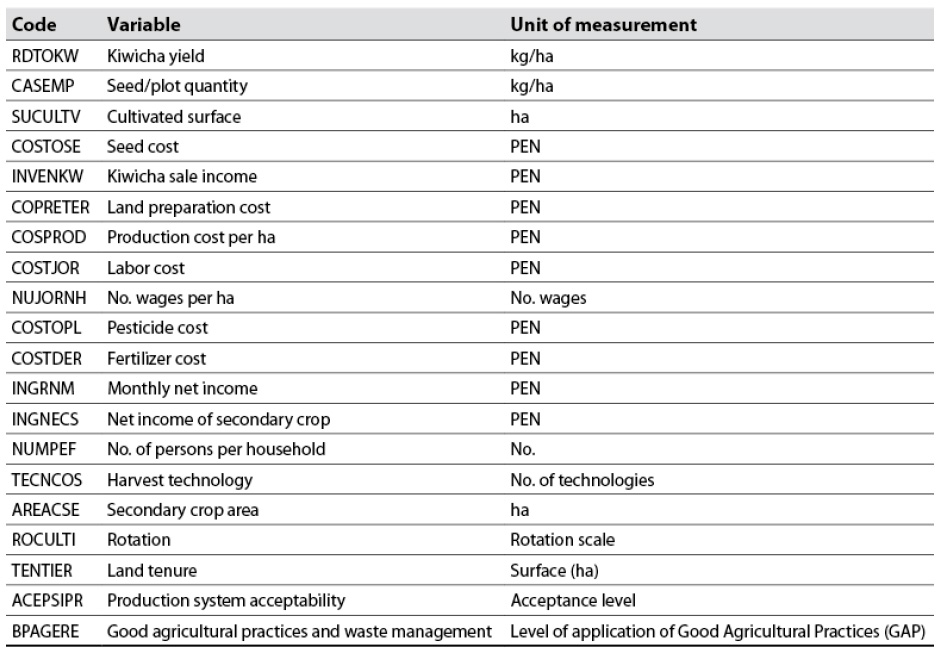
Note:Exchange rate at the moment the evaluation was carried out: 1 PEN = 0.298 USD
Source: Elaborated by the authors
The characterization of the kiwicha production units was carried out based on the results of the IV National Agricultural Census (INEI, 2013) and the information collected from surveys applied in the field. Initially, the specific theoretical framework for the typification of the productive units was determined, and later, the variables under study were selected to know the reality of the production systems (Escobar & Berdegué, 1990).
A questionnaire format was developed with structured questions to capture information on the farming system and socio-economic aspects (Álvarez et al., 2014; Pinedo et al., 2018). The information collected through the questionnaires was ordered and systematized in a spreadsheet employing the Excel® 2013 tool. Subsequently, the data were processed with the SPSS v22 and Infostat software. For the principal component analysis (PCA), quantitative variables were used, while some categorical variables were transformed into a numerical scale.
Of the 61 variables under study, those with a coefficient of variation (CV) lower than 40 % were discarded because they lacked discriminatory power and did not contribute substantially to the multivariate analysis (Lores et al., 2008). With 20 variables selected for their higher discriminatory power, the PCA was performed using Ward’s method and the Varimax rotation technique (Carrasco et al., 2017; Criollo et al., 2016; Velázquez & Perezgrovas, 2017).
The statistical management of the data was carried out with the Statistical Package for the Social Sciences (SPSS). All the selected quantitative variables were standardized by transforming them into Z values to eliminate the scale and unit of measurement values (uniformity in the measurement units used); in this way, the influence of different levels of measurement units was avoided (García & Calle, 1998; Velázquez & Perezgrovas, 2017).
Influential variables in group formation, and those highly correlated with each other were identified (Tuesta et al., 2014). The components with axes whose eigenvalue was higher than 1.0, or that explained more than 60 % of the variability were selected (Álvarez et al., 2014).
For the cluster analysis, 20 discriminant variables were used employing the hierarchical grouping technique (Tovar et al., 2015), which helped to form homogeneous groups of systems with similar characteristics or typologies, with minimal variability within the group and maximal between groups (Coronel de Renolfi & Ortuño, 2005; Paz et al., 2000; Tovar et al., 2015), facilitating the understanding of the complexity of the systems (Álvarez et al., 2014).
Results and discussion
Distribution of the surveyed population by communities
Kiwicha crops were found in all the AU studied as part of the predominant diversified production system in the area. Regarding the location and percentage of farmers with kiwicha fields, the largest number of producers are located in the community of Santa Cruz (34.7 %), followed by Yungay (22.3 %), Mato (21.5 %), and Parihuanca (10.7 %), while in the community of Tinco (5.8 %) had the lowest amount of AU with this crop. In this regard, Barreto (2017) points out that, in the AU where kiwicha cultivation is found, this species is not necessarily the main crop, but part of their traditional diversified production system.
Concerning the role that men and women play, in the communities of Matos, Santa Cruz, and Yungay, the responsibility of men managing the plots compared to women is higher, while in Pariahuanca and Tinco, the AU is in charge of women (figure 1). According to INEI (2013), of the population registered in the department of Ancash, 64.8 % are men and 35.28 % are women; however, the demographic and family health survey carried out by the National Institute of Statistics and Informatics (INEI, 2014) indicated that the rural female population in Ancash is 47.5 %. The role of women is key in parcel unit management, as well as in resources conservation and income generation (Comunidad Andina de Naciones [CAN], 2011; Minagri, 2015).
Women have adapted and followed useful traditional and technological practices for each production type in which they are involved. However, despite being the backbone of food production and supply for family consumption, women face even greater limitations due to a series of cultural, traditional, and sociological factors, such as the limited openness in making decisions about the community or the occupation of managerial positions (Caselato & Amaya, 2012; González et al., 2015; Sánchez & Navarrete, 2017; Vieyra et al., 2014).

Source: Elaborated by the authors
Figure 1 Percentage distribution of the population of men and women in the management tasks of kiwicha production units in the study area. Department of Ancash, 2016-2017
Regarding the age of the producers, in the communities of Mato, Pariahuanca, Santa Cruz, Tinco, and Yungay, 71.0 % are between 22 and 50 years old, while 15.2 % are between 71 and 89 years of age (figure 2). Currently, the proportion of working-age persons in the rural regions of the study area is 57.5 % (INEI, 2014). This information is complemented by the Regional Government of Ancash (Gobierno Regional de Ancash [Gorea], 2008), which states that 70.8 % of the population is of working age.

Source: Elaborated by the authors
Figure 2 Groups of kiwicha producers classified by age in the provinces of Yungay, Huaylas, and Carhuaz, Ancash, 2016-2017
Regarding the level of education, five levels were identified: 27.0 %, with a partial or total level of higher education; 33.0 %, with incomplete and complete secondary school; 26.1 %, with some level of primary education; 0.2 %, with initial or pre-school level, and 13.8 % are considered illiterate; therefore, 86.3 % can read and write.
Thanks to the educational policy of the governments of the last 15 years, the illiteracy rate has decreased and is reflected in a higher percentage of inhabitants of rural areas with some level of education. In the last five years, the illiteracy rate has decreased from 7.1 % to 5.9 %, among other factors, due to the increase in migration to cities or populated centers where persons have better opportunities to access educational services (Pinedo et al., 2017).
Education can be an influencing factor in the adoption of technologies (Ayora, 2015; Centro Internacional de Mejoramiento de Maíz y Trigo [Cimmyt], 1993; Pinedo et al., 2017). However, in peasant family farming contexts, the innovation of learning processes is recommended. In this regard, Pinedo (2019) mentions that the farmer field school (FFS) methodology allows information to be processed, and based on the analysis of the plots in agroecosystems, knowledge to solve crop management problems is generated due to its learning by doing principle.
The place of residence preferred by producers is associated with the age, expectations of the population, and opportunities found in their environment. Fifty-four percent of the farmers reside on the farm; 34 % in a populated center close to the farm, 15 % in the city, 5 % between the farm and the populated center, and the remaining 2 % did not specify. In this regard, Apollin and Eberthart (1999) and Pinedo et al. (2018) indicated that housing quality and the services they have is a determining factor for the permanence of producers in rural areas and close to their agricultural units.
In the AU evaluated, 43.9 % of the farmers have adobe houses in good condition; 54.9 % have adobe houses in fair conditions, while 1.20 % have dilapidated housings and in poor conditions. Likewise, 80.5 % have water, sewage, and electricity services, while 1.2 % only have water from springs. In this regard, Gorea (2008), in the population and housing studies of Ancash, found that 83.2 % of the housings located in rural areas had access to drinking water, and only 41.7 % of these had access to drainage.
Basic need satisfaction in the rural populations and its effect on the better living conditions of the inhabitants can be a key factor to encourage the permanence of producers in the field (Córdova, 2009). However, this requires promotion policies to improve the management and profitability of their AU (Pinedo et al., 2018), considering that the world market for amaranth is extending, mostly because of the possibilities of better socio-economic conditions offered by the crop (González et al., 2015; Sánchez et al., 2016).
Regarding the land tenure variable, in the five communities assessed, 67.1 % are owners, while 22 % are in the process of titling their land. In the last 15 years, the land tenure situation has changed. The number of AUs has increased in plots whose average surface reaches 0.8 ha (INEI, 2013), making it challenging to implement production plans in scale economies (Maletta, 2017).
Regarding the generation of family employment, the study indicates that 39 % of the labor force comes directly from the family, 24.4 % are hired workers, and 35 % uses family labor as well as hired labor. Barreto (2017) indicated that in Carhuaz, 56.1 % of the families use only family labor, 22.1% use paid labor, and 21.80 % use both labor forms. Based on the results, there is a type of family farming in the transition towards production models more integrated into the market, since a high percentage of the families hire laborers in poorly diversified production systems with a monoculture tendency, even in smallholdings (Barreto, 2017; CAN, 2011; Instituto Interamericano de Cooperación para la Agricultura [IICA], (2015); Minagri, 2015; Pinedo et al., 2017).
The predominant crops in the study area are wheat (Triticum aestivum L.), corn on the cob (Z. mays L.), potato (Solanum tuberosum L.), pea (Pisum sativum L.), and barley (Hordeum vulgare L.); on a smaller scale, kiwicha, quinoa (Chenopodium quinoa Willd.), fruits, and subsistence crops such as squash (Cucurbita maxima Duch.) (figure 3). According to Barreto (2017), at the Ancash department level, in production areas located between 2,650 and 2,900 m a.s.l., the four most important crops are potato, corn, beans, and forages, mainly alfalfa (Medicago sativa L.).
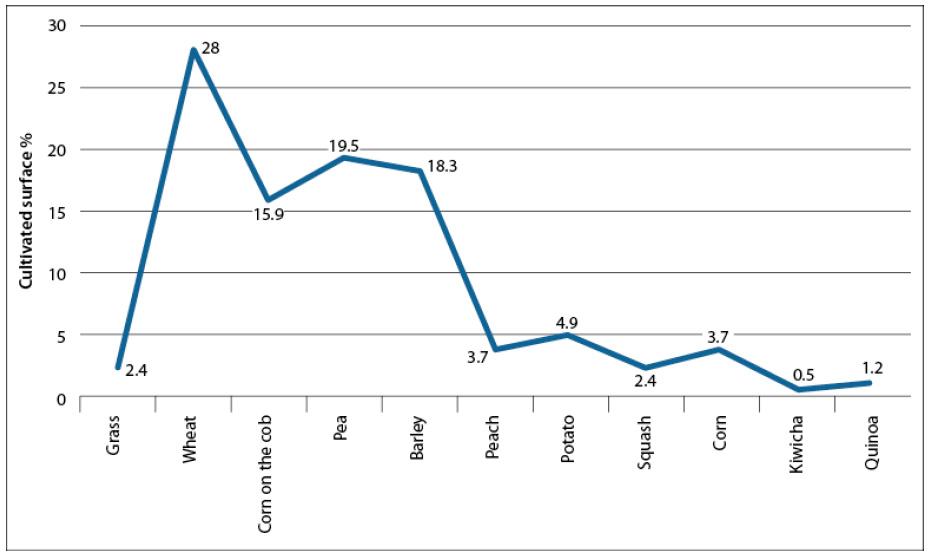
Source: Elaborated by the author
Figure 3 Area percentage dedicated to different main crops in Santa Cruz and Huaylas, in the department of Ancash
In relation to the technological gaps, according to INEI (2013), of the 2,164,000 producers, only 10 % received some type of training and technical assistance. The study indicates that the technology used in the cultivation of kiwicha is medium to low.
As the area cultivated with kiwicha is reduced, the producers conserve traditional production models, while in areas larger than one hectare, they adopt technological packages that include the use of certified seed and agrochemicals. In very small plots, soil preparation is done manually and with animal traction. Barreto (2017) indicated that in the management of the AUs, certain traditional practices are used, including minimum tillage with traditional tools and implements, and the use of their own seed; these areas preserve their characteristics. It is evident that traditional management continues to be a viable technological alternative for the fragile agroecosystems of the inter-Andean valleys of Ancash and can be economically sustainable if the producer generates sufficient income for family maintenance (Pinedo, 2019; Sánchez et al., 2016; Sarandón, 2002).
Principal Component Analysis (PCA)
Through a PCA and using 20 variables with the highest discriminatory power and not correlated with each other (table 1), four principal components that contribute to explain 75.5 % of the determined variance were obtained (table 3).
Table 3 Eigenvalues of the correlation matrix and contribution levels (%) of the variance of the kiwicha production units

Source: Elaborated by the authors
The readjusted values with the rotated component matrix are shown in table 4. Component 1 (C1) is the most influential and explains the typology of producers (51.01 %) and the variables that affect the production costs of kiwicha cultivation. Component 2 (C2) explains the resources and technology of producers. Component 3 (C3) refers to the levels of ecological awareness of the producer, and component 4 (C4), which contributes with 6.66 %, explains the food safety strategies of the producer in polyculture systems. Regarding components C3 and C4, Pinedo et al. (2018) and Sarandón (2002) indicated that the segments of producers who practice traditional cultivation systems show higher ecological awareness in the management of their resources and, as part of their food security strategies, they practice crop rotation, association, and productive diversification (CAN, 2011; Maletta, 2017).
Cluster analysis
Three clusters were formed (figure 4); each group shows similar production systems inside, considering the four new synthetic variables found in the PCA (Coronel de Renolfi, & Ortuño, 2005; Paz et al., 2000), as follows: cluster 1 (CG1) includes smallholding producers; cluster 2 (CG2) comprises small producers, and cluster 3 (CG3) is composed of medium producers. The typification variables that determined the clusters were the production scale and cultivated area of kiwicha (Coronel de Renolfi & Ortuño, 2005; Maletta, 2017; Pinedo et al., 2018).
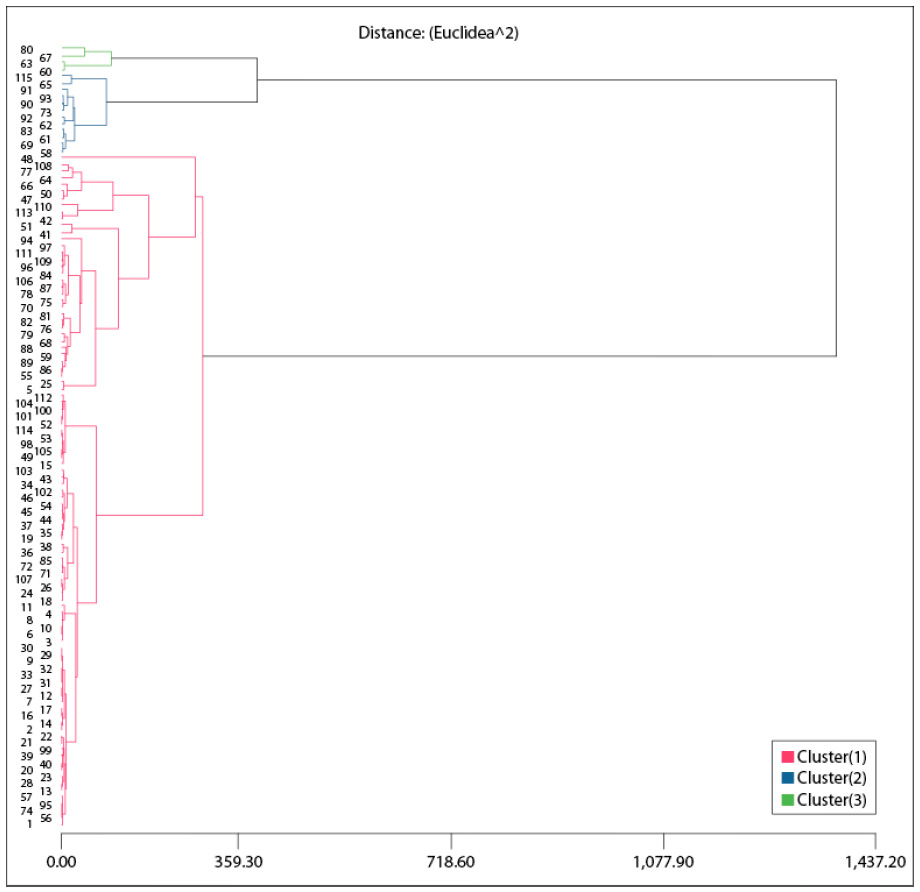
Source: Elaborated by the authors
Figure 4 Typification dendrogram of smallholding, small and medium producers of kiwicha in the study area of the department of Ancash, Peru
In the individual analysis by communities, in Mato and Pariahuanca, only smallholdings producers were recorded, while in Santa Cruz, the three types of producers were found; in Tinco and Yungay, smallholding and small producers were recorded (table 5).
Regarding the percentage of producers per community, 115 farmers who integrate kiwicha cultivation in their AU were identified, of which 36.52 % of the producers are found in Santa Cruz, 23.48 % in Yungay, 22.61 % in Mato, 11.30 % in Pariahuanca, and 6.09 % in Tinco.
Concerning land tenure, smallholding farmers own 0.56 ha of land on average, small producers 1.14 ha, and medium producers 6.13 ha. According to the classification carried out by IICA (2015), Maletta (2017), and Pinedo et al. (2017), these authors pointed out that smallholding producers own less than 1 ha, the group of small producers up to 3 ha, and the third group —medium producers— own more than 5 ha.
According to the established classification, CG1 would be considered a type of subsistence family agriculture (CAN, 2011; Escobal, 2015; Maletta, 2017). Producers in this segment, lack sufficient land, livestock, or productive infrastructure to generate monetary or non-monetary income that allows them to cover their basic food basket or minimum caloric requirements. At the same time, CG2 and CG3 could belong to the family farming group that is in transition, due to having surpluses for the market (CAN, 2011).
Table 5 Typology of producers concerning the distribution of farmers with kiwicha cropping, age, number of persons per family, experience in kiwicha cultivation, and land tenure
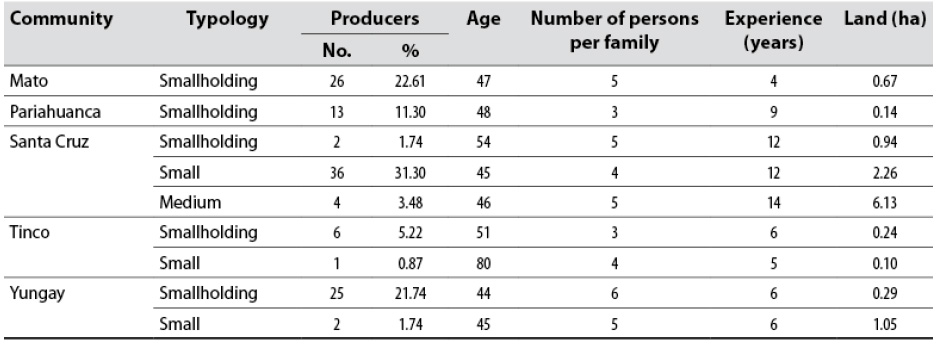
Source: Elaborated by the authors
The economic income and profitability of kiwicha cultivation resulted from the contribution of seven variables (table 6). The lowest economic income was found in CG1 producers with an average monthly net income of PEN 130.20. In the case of CG2, the average monthly net income is higher than CG1 by 27.05 % since they generate a monthly income of PEN 178.47. The medium-sized producers of CG3 generate the highest average economic income (PEN 493.50), and surpass CG2 and CG1 by 176.52 % and 279.03 %, respectively. None of the groups reaches the minimum living wage established by the Peruvian government (PEN 850).
Table 6 Variables of influence on the economic sustainability of the agricultural units of kiwicha production
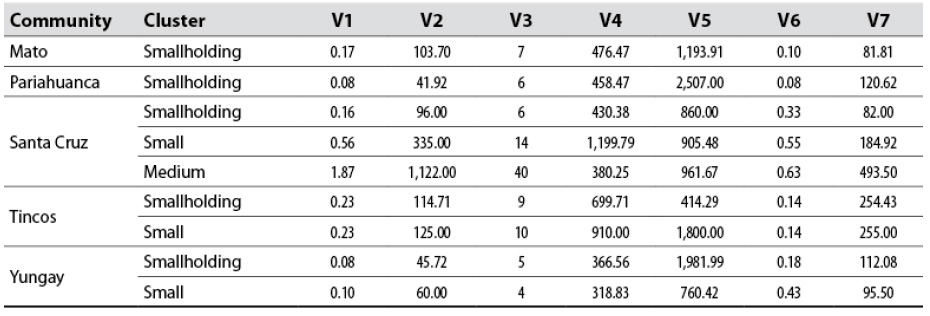
Note:cultivation area (V1), land preparation cost (V2), No. of wages (V3), production cost (V4), yield in kg/ha (V5), surface of secondary crop in ha (V6), and monthly net income (V7). (figures in PEN). Exchange rate = 3.35 USD (1 PEN = 0.298 USD).
Smallholding producers show the lowest levels of V7, reflected by small-scale agriculture with an average area of 0.14 ha, while medium-sized producers, with 0.30 ha, use their production for self- consumption and the scarce surplus for sale in the local market. Possibly, these two segments of producers can increase their cultivation areas, but there is little evidence of promotion to cultivate this crop. Hence, the trend in the coming years will be for a smaller cultivated area of kiwicha (Minagri, 2017). The highly fragmented type of agriculture limits scaling up producer economies (CAN, 2011; Maletta, 2017); on the contrary, small and medium-sized producers may have better possibilities of negotiation and integration into the market (IICA, 2015; Pinedo et al., 2018; Sánchez et al., 2016).
According to the United Nations Development Programme (PNUD, 2017), in Peru, the economy grew by 87 %, and poverty fell from 58.7 % to 22.7 % between 2004 and 2015, classifying it as a country with a high human development index (0.73). Nonetheless, structural inequalities persist in the study area, especially between the poor and the vulnerable, with the highlands being the most vulnerable with a poverty rate of 49 %. According to INEI (2016), the average monthly cost of the family food basket in the rural area of the Sierra region (montane) is PEN 234, and the average monthly per capita income in the rural area of this same region is PEN 417. The average monthly income of the three clusters, i.e., smallholdings, small- and medium-sized producers, reach an average of PEN 130.20, PEN 178.47, and PEN 493.50, respectively. These values reflect a level of monetary poverty (PNUD, 2017) compared to the economic income of the producers.
Possibly only medium producers will remain in this productive activity in the following years. Finally, producers of the three typologies identified in light of their monthly net income levels are inferred to contribute very little to the sustainability of kiwicha cultivation. A system must generate sufficient economic income, facilitate access to goods and services, and contribute to the proper use of natural resources to be sustainable (Sarandón, 2002).
Therefore, considering that kiwicha is widely recognized for its high protein content and nutritional qualities (Caselato & Amaya, 2012), as well as its ability to adapt to various climatic and environmental conditions, it is an alternative to face the challenges imposed by climate change (Ponce et al., 2015). Furthermore, kiwicha is a feasible strategy to contribute to national food security (CAN, 2011; Minagri, 2015), while remaining a viable alternative to ensure sustainable economic income (González et al., 2015; Maletta, 2017; Sánchez & Navarrete, 2017; Sánchez et al., 2016).
Conclusions
The analysis carried out to the 115 kiwicha production units allowed the identification of three types of producers comprised of groups of relatively nearby farms, according to the criteria of the variables used. On the other hand, a set of observations was obtained on the production and financing structures of the farms and the composition of the variables that characterize them.
Women play an essential role in driving and generating family income in the units evaluated. However, their role is only limited to primary production, wasting the potential of kiwicha grains. Due to its high protein content (14 % to 17 %), this crop can be a great opportunity to revalue the role of women by integrating their knowledge and cultivation practices with the generation of added value through rural community industries.
Kiwicha production is minimal within the cultivation certificate of the producer, i.e., its importance is significant from the point of view of family food security. On the other hand, in the global context of the productive unit, it is an activity characterized by its low profitability and little contribution to the generation of income for the families dedicated to its cultivation.
However, given the current climate change context (recurrent presence of adverse climatic phenomena such as drought and heatwaves caused by the increase in temperatures) and due to the agronomic characteristics of the crop, it is a viable alternative to improve local food security and the socio-economic situation of producers.











 text in
text in 


